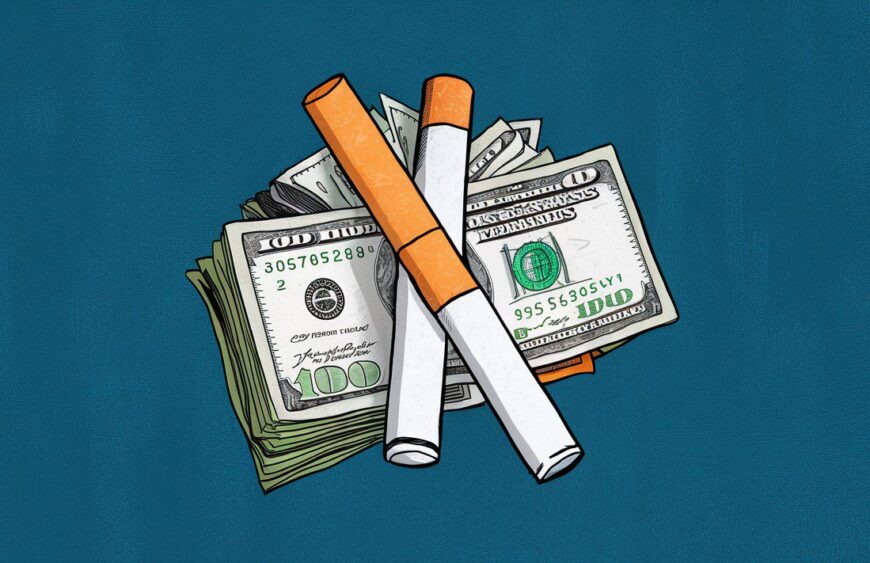British Columbia, famous for its breathtaking scenery and lively cities, also faces ongoing discussions about the cost of living, including the price of cigarettes. Exploring the tobacco market in BC reveals various factors influencing cigarette prices. This piece, titled “Smoke Signals: Understanding Cigarette Pricing Trends in BC,” aims to explain the complexities behind cigarette pricing in the province, offering a detailed view of what shapes costs in this market.
Cigarette prices in British Columbia aren’t solely determined by companies; they’re also heavily impacted by provincial and federal taxes aimed at reducing smoking rates for public health reasons. These taxes, combined with regulations, significantly affect the retail price, positioning BC as one of Canada’s provinces with the highest cigarette prices. These high costs are justified by public health goals, government revenue needs, and environmental concerns related to cigarette waste.
Examining historical patterns, current situations, and future expectations of cigarette prices in BC provides a comprehensive understanding of the influencing factors. From tax increases and anti-smoking initiatives to concerns about the black market and cross-border shopping, each element contributes to the intricate dynamics of cigarette pricing. Whether you’re a smoker facing the challenge of higher prices, a policymaker strategizing tobacco control measures, or simply interested in the intersection of economics and public health, this overview aims to clarify the complexities of cigarette pricing in British Columbia.
Price Trends in BC
The cost of cigarettes in British Columbia isn’t just about supply and demand; it’s a mix of many factors. Taxes from both the provincial and federal governments have a big impact on how much smokers pay. Understanding these factors helps us see why cigarettes cost what they do and why certain rules are in place.
Taxes and Charges: The Big Influencers
In BC, taxes make up a large chunk of the cigarette price. The federal government puts a tax on every cigarette sold in Canada, and BC adds its own extra taxes. These taxes make cigarettes more expensive, aiming to make smoking less appealing and cover the costs of healthcare for smoking-related illnesses.
Rules that Affect Prices
Regulations also affect cigarette prices. Laws on advertising, packaging, and where cigarettes are sold indirectly affect costs by limiting how companies can market their products. BC also sets a minimum price for cigarettes to stop prices from dropping too low. This prevents price wars that could make cigarettes cheaper and more appealing to younger or budget-conscious smokers.
The Role of Supply Chain and Retail Markup
Besides taxes and rules, how cigarettes get from makers to stores and the markups along the way also affect their price. Each step – importing, wholesaling, and selling – adds costs for things like shipping and storage. Everyone in the chain, like importers and retailers, marks up the price to cover their expenses and make a profit. Retailers might change their markup depending on where they are, who they’re up against, and who’s buying, which affects how much cigarettes cost in stores.
The Impact of Smuggling and Illegal Sales
Another thing that influences cigarette prices in BC is smuggling and illegal selling. Because taxes and rules make cigarettes pricey, some people sell them without paying taxes. This hurts the government’s income and messes up the market, making it hard to set prices and meet health goals. Authorities try to stop this, but it’s tough, showing how tangled the issue of cigarette prices can be.
Cigarette prices in British Columbia are shaped by taxes, rules, how they get to stores, and the problem of illegal selling. All these things make cigarettes cost a lot in BC, as part of a plan to cut down on smoking while thinking about money and health. Knowing all this helps understand why cigarettes are so expensive in BC.

Historical Trends of Cigarette Prices in BC
The story of cigarette pricing in British Columbia unfolds through a series of gradual increments, influenced by changes in government policies, public health initiatives, and economic factors. This historical journey unveils the shaping forces behind today’s pricing landscape.
Early Regulations and Pricing
In the late 20th century, BC’s government began acknowledging smoking’s public health risks, initially setting modest taxes on cigarettes to balance revenue and consumer behavior. However, as evidence linking smoking to health issues grew, taxes increased to deter smoking.
The Shift Towards Higher Taxes
Entering the early 2000s, BC, like the rest of Canada, enforced substantial tax hikes on tobacco products, aligning with broader efforts to curb smoking rates. The strategy was straightforward: pricier cigarettes would dissuade consumption, particularly among young people sensitive to price changes.
Impact of Tax Increases on Pricing Trends
Tax hikes have significantly pushed up cigarette prices over the years, resulting in a steady upward trend. With each tax increase, retail prices have followed suit, directly affecting consumers’ wallets. Alongside these hikes, specific policies aimed at controlling the tobacco market, like advertising and public smoking restrictions, have indirectly influenced pricing by reducing demand.
Recent Years and Price Stabilization
In recent times, the pace of price hikes has somewhat leveled off, though prices still outpace inflation rates. This stabilization is partly because as prices hit certain levels, further increases have diminishing effects on reducing smoking rates. Moreover, the government has to balance its health goals with the challenges of smuggling and illegal trade, which become more tempting as legal prices soar.
Looking Back to Look Forward
A glance at the history of cigarette pricing in BC underscores the use of pricing as a tool for public health. From modest beginnings to today’s high prices, the trend reflects an increasing awareness of smoking’s true costs — both in health and economics. This historical backdrop provides insight into current pricing strategies and hints at future trends.
Current State of Cigarette Prices in BC
In recent times, British Columbia has continued its pattern of raising cigarette prices, making it one of the most expensive places to smoke in Canada. Understanding the reasons behind this trend involves looking at factors like taxes, living costs, and how BC compares to other areas.
Taxation: The Main Influence
Taxes play the biggest role in determining cigarette prices in BC. Both federal and provincial taxes eat up a significant chunk of the retail price, aiming to discourage smoking by making it expensive. The current tax rates show the government’s ongoing push for public health through financial measures.
Comparison with Other Provinces
When compared to the rest of Canada, BC’s cigarette prices stand out for being high. This difference is because BC takes a strong stance on smoking and public health. While all provinces use taxes to control smoking, BC goes further with extra taxes and price laws, pushing prices higher than places like Quebec or the Atlantic provinces.
The Cost of Living and Its Impact on Prices
Living costs in BC, especially in cities like Vancouver, rank among Canada’s highest. This indirectly affects cigarette prices because retailers pass on their higher expenses to consumers. So, cigarette prices in BC don’t just reflect taxes but also the province’s overall pricey living conditions.
Consumer Responses and Market Dynamics
BC’s expensive cigarettes have triggered varied consumer reactions: fewer people smoking, more buying smuggled smokes, and others crossing borders for cheaper deals. These responses highlight how price, behavior, and public health goals intertwine. Despite high prices, demand for cigarettes persists due to addiction and the perceived value of smoking.
Looking Ahead
BC’s current cigarette prices balance health goals, tax policies, and market conditions. As the government continues prioritizing health with taxes, prices will likely stay high. Yet, efforts against smuggling and illegal sales, plus campaigns to further cut smoking rates, will shape future cigarette prices in the province.
The Impact of Cigarette Prices on Smoking Rates in BC
The link between cigarette prices and smoking rates is crucial for both public health experts and economists in British Columbia. High cigarette prices in the province have been deliberately used to curb smoking rates, leading to noticeable changes over time.
The Theory Behind Price Increases
It’s simple logic: when cigarette prices go up, smoking becomes more expensive, so people smoke less. This idea is backed by research showing that higher prices lead to fewer smokers, especially among young people who are sensitive to price changes.
Evidence of Impact in BC
In BC, there’s strong evidence that higher prices reduce smoking. Over the years, as cigarette prices climbed, smoking rates dropped. While other factors like public health campaigns and bans on smoking also helped, the price of cigarettes played a big role.
Differential Impact Across Demographics
The effect of cigarette prices on smoking rates varies among different groups in BC. Younger people, often with limited money, feel the pinch of price hikes the most. However, older, wealthier smokers are less sensitive to price changes, though they still notice them to some degree.
The Role of Alternatives and Illicit Markets
One unintended result of expensive cigarettes is that some smokers may switch to other nicotine products or buy from illegal sources. This poses a challenge for public health efforts to cut overall tobacco use.


Future Considerations
BC’s public health officials face a tough task: finding the right balance where cigarette prices deter smoking without pushing people to buy illicit products or failing to affect long-time smokers. Achieving this balance means staying alert and adjusting strategies to keep reducing smoking rates effectively and steadily.
Future Outlook for Cigarette Prices in BC
Looking ahead, it’s likely that cigarette prices in British Columbia will keep going up, driven by various factors like public health policies, tax changes, and market forces. Let’s explore what could happen to cigarette pricing in the province in the coming years.
Continued Emphasis on Public Health
BC’s health authorities are still focused on cutting smoking rates, with price hikes being a key strategy. Since raising prices has worked in the past to discourage smoking, taxes on cigarettes will probably keep going up. The aim is to make smoking less affordable, especially for young people who are sensitive to price changes.
Taxation and Regulation Adjustments
Future tax and regulation changes will likely aim not just to reduce smoking rates, but also to tackle challenges from other nicotine products and the black market. Policymakers may tweak rules to make sure that higher cigarette prices don’t push people towards these alternatives.
Impact of Inflation and Economic Factors
Economic factors such as inflation and shifts in the cost of living exert a significant influence on cigarette pricing dynamics in British Columbia. As inflation drives up the general price level of goods and services, including operational costs within the tobacco industry, the resulting upward pressure contributes to higher cigarette prices. This rise is further compounded by direct tax increases, reflecting both provincial and federal levies, which are often adjusted to align with economic shifts. Indirectly, inflation can also inflate costs throughout the supply chain, from manufacturing to retail, thereby elevating the final retail price of cigarettes for consumers.
Technological and Market Innovations
The continuous evolution of the tobacco industry, characterized by the introduction of novel products and technological advancements, introduces a level of uncertainty regarding future cigarette pricing in BC. Innovations such as e-cigarettes and heat-not-burn devices offer smokers alternative options, potentially impacting the demand for traditional cigarettes. Consequently, public health policies must adapt to these changes, potentially altering taxation and regulatory frameworks to address emerging products and market dynamics. The interplay between technological advancements, consumer preferences, and regulatory responses will shape the trajectory of cigarette prices in the province.
Public Opinion and Societal Changes
Public sentiment and societal norms surrounding smoking play a pivotal role in shaping future cigarette prices in BC. With an increasing emphasis on health and wellness, there is a growing societal aversion to smoking, leading to heightened support for measures aimed at reducing tobacco use. This includes favoring policies that make smoking less affordable and less socially acceptable, which could manifest in further tax hikes and stricter regulations. As public awareness of the health risks associated with smoking continues to rise, there is a shifting tide towards prioritizing public health objectives over economic considerations in tobacco policy decisions.
The Future of Cigarette Prices in BC
Looking ahead, the trajectory of cigarette prices in British Columbia is expected to reflect a complex interplay of economic, technological, and societal factors. While inflation and economic shifts will continue to exert upward pressure on prices, technological innovations and changing market dynamics introduce new variables into the equation. Concurrently, evolving public opinion and health priorities are likely to drive further policy interventions aimed at reducing smoking rates and improving public health outcomes. Ultimately, the future of cigarette prices in BC hinges on the ability of policymakers to navigate these multifaceted challenges and strike a balance between economic interests and public health objectives.



